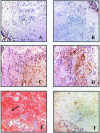Mechanisms of abruption-induced premature rupture of the fetal membranes: thrombin-enhanced interleukin-8 expression in term decidua
- PMID: 16251427
- PMCID: PMC1603775
- DOI: 10.1016/S0002-9440(10)61230-8
Mechanisms of abruption-induced premature rupture of the fetal membranes: thrombin-enhanced interleukin-8 expression in term decidua
Abstract
Recent evidence has linked preterm premature rupture of the fetal membranes (PPROM) to placental abruption. Because neutrophils are a rich source of proteases that can degrade extracellular matrix in abruption-associated PPROM, we examined whether decidual neutrophil infiltration complicates abruption-associated PPROM. Accordingly, immunostaining for the neutrophil marker CD15 was performed in placentas obtained after overt abruption (decidual hemorrhage) with or without PPROM and in control placentas. Abruptions were associated with a marked decidual neutrophil infiltration that peaked after PPROM, whereas decidua from gestational age-matched controls were virtually devoid of neutrophils. Neutrophil infiltrates co-localized with fibrin deposition. Because abruptions elicit intense decidua-enhanced thrombin production, we examined the regulation of abruption-induced neutrophil infiltration. Expression of the primary neutrophil chemoattractant interleukin-8 (IL-8) was evaluated in leukocyte-free term decidual cells incubated with estradiol (E2; control) or with E2+medroxyprogesterone acetate (to mimic pregnancy)+/-thrombin. After 24 hours, enzyme-linked immunosorbent assay measurements indicated that thrombin (0.1 to 2.5 U/ml) elicited a dose-dependent elevation in secreted IL-8 (P<0.05) with 2.5 U/ml of thrombin increasing IL-8 levels by >14-fold in E2 and E2+medroxyprogesterone incubations. Results were validated by Western blot and quantitative reverse transcriptase-polymerase chain reaction. In summary, thrombin-enhanced IL-8 expression in term decidual cells may explain how abruption-associated PPROM promotes decidual neutrophil infiltration.
Figures






Similar articles
-
Thrombin-Induced Decidual Colony-Stimulating Factor-2 Promotes Abruption-Related Preterm Birth by Weakening Fetal Membranes.Am J Pathol. 2020 Feb;190(2):388-399. doi: 10.1016/j.ajpath.2019.10.020. Am J Pathol. 2020. PMID: 31955792
-
Abruption-induced preterm delivery is associated with thrombin-mediated functional progesterone withdrawal in decidual cells.Am J Pathol. 2012 Dec;181(6):2138-48. doi: 10.1016/j.ajpath.2012.08.036. Epub 2012 Oct 9. Am J Pathol. 2012. PMID: 23058370 Free PMC article.
-
Mechanisms of abruption-induced premature rupture of the fetal membranes: Thrombin enhanced decidual matrix metalloproteinase-3 (stromelysin-1) expression.Am J Obstet Gynecol. 2004 Dec;191(6):1996-2001. doi: 10.1016/j.ajog.2004.08.003. Am J Obstet Gynecol. 2004. PMID: 15592282
-
Involvement of human decidual cell-expressed tissue factor in uterine hemostasis and abruption.Thromb Res. 2009 Nov;124(5):516-20. doi: 10.1016/j.thromres.2009.07.017. Epub 2009 Aug 31. Thromb Res. 2009. PMID: 19720393 Free PMC article. Review.
-
The role of decidualization in regulating endometrial hemostasis during the menstrual cycle, gestation, and in pathological states.Semin Thromb Hemost. 2007 Feb;33(1):111-7. doi: 10.1055/s-2006-958469. Semin Thromb Hemost. 2007. PMID: 17253197 Review.
Cited by
-
Progestins Inhibit Interleukin-1β-Induced Matrix Metalloproteinase 1 and Interleukin 8 Expression via the Glucocorticoid Receptor in Primary Human Amnion Mesenchymal Cells.Front Physiol. 2020 Jul 24;11:900. doi: 10.3389/fphys.2020.00900. eCollection 2020. Front Physiol. 2020. PMID: 32792990 Free PMC article.
-
Novel insights into molecular mechanisms of abruption-induced preterm birth.Expert Rev Mol Med. 2010 Nov 1;12:e35. doi: 10.1017/S1462399410001675. Expert Rev Mol Med. 2010. PMID: 21040617 Free PMC article. Review.
-
A link between a hemostatic disorder and preterm PROM: a role for tissue factor and tissue factor pathway inhibitor.J Matern Fetal Neonatal Med. 2008 Oct;21(10):732-44. doi: 10.1080/14767050802361807. J Matern Fetal Neonatal Med. 2008. PMID: 19012190 Free PMC article.
-
Abruption-associated prematurity.Clin Perinatol. 2011 Sep;38(3):407-21. doi: 10.1016/j.clp.2011.06.001. Clin Perinatol. 2011. PMID: 21890016 Free PMC article. Review.
-
Predictors of Inflammation-Mediated Preterm Birth.Physiology (Bethesda). 2025 Jan 1;40(1):0. doi: 10.1152/physiol.00022.2024. Epub 2024 Aug 6. Physiology (Bethesda). 2025. PMID: 39106300 Free PMC article. Review.
References
-
- Harger JH, Hsing AW, Tuomala RE, Gibbs RS, Mead PB, Eschenbach DA, Knox GE, Polk BF. Risk factors for preterm rupture of fetal membranes: a multicenter case-control study. Am J Obstet Gynecol. 1990;163:130–137. - PubMed
-
- Salafia CM, Lopez-Zeno JA, Sherer DM, Whittington SS, Minior VK, Vintzileos AM. Histologic evidence of old intrauterine bleeding is more frequent in prematurity. Am J Obstet Gynecol. 1995;173:1065–1070. - PubMed
-
- Darby MJ, Caritis SN, Shen-Schwarz S. Placental abruption in the preterm gestation: an association with chorioamnionitis. Obstet Gynecol. 1989;74:88–92. - PubMed
-
- Polzin WJ, Brady K. The etiology of premature rupture of the membranes. Clin Obstet Gynecol. 1998;41:810–816. - PubMed
-
- Romero R, Chaiworapongsa T, Espinoza J, Gomez R, Yoon BH, Edwin S, Mazor M, Maymon E, Berry S. Fetal plasma MMP-9 concentrations are elevated in preterm premature rupture of the membranes. Am J Obstet Gynecol. 2002;187:1125–1130. - PubMed
Publication types
MeSH terms
Substances
Grants and funding
LinkOut - more resources
Full Text Sources

